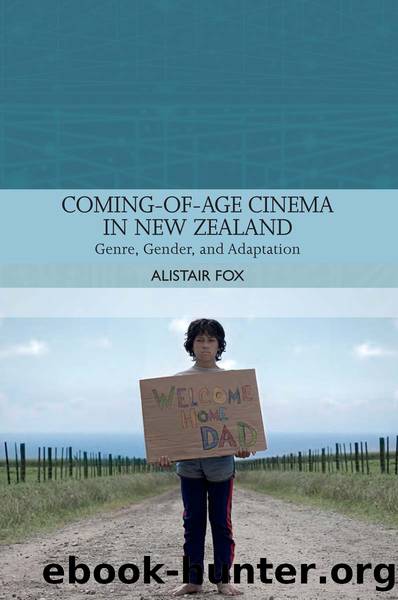Coming-Of-Age Cinema in New Zealand by Fox Alistair;

Author:Fox, Alistair;
Language: eng
Format: epub
Publisher: Edinburgh University Press
Figure 10.1 Terrified children listen to their parents fighting in Once Were Warriors (dir. Lee Tamahori, 1994).
For the violence in the film, the director drew upon his own experience. The son of a MÄori father and a PÄkehÄ mother, Tamahori reveals that âI had grown up amongst a lot of that, seen a lot of it in my sort of âyoung man drinkingâ days.â24 While his own family was not like that â Tamahori says he had a poor, but loving working-class upbringing â he nevertheless âcame out of a young manâs hard drinking culture with fights erupting in bars all the time. I knew street violence, not from taking part in it, but from dodging it all the time. I also know my own east coast Maori community pretty well.â25 Thus, on top of the passionate indignation emanating from Alan Duffâs personal experience, there was superimposed a further layer of emotional investments that helped to influence the reshaping of the story in the process of its transposition from page to screen.26
THE GENRIFICATION OF ONCE WERE WARRIORS
In order to adapt Duffâs novel, Tamahori was faced with a need to find ways of making it more cinematic. Whereas Duff had painted on a very broad canvas, contrasting the lives of the MÄori who live in the abject squalor of the Pine Block housing estate with the affluent and genteel lifestyle of a PÄkehÄ family who live in a mansion at the top of the hill, and included a whole series of interior monologues as the narrative perspective shifts from one character to another, Tamahori achieves a tighter unity of action by narrowing the focus to emphasize family issues more, and by reconstructing the novel so that it becomes more concerned with Bethâs personal growth.27 At the same time, âin the film, the young people are clearly portrayed more positively than in the novel,28 which helps to give the movie an âupâ ending,â as Riwia Brown puts it.29 This is why it is important to acknowledge the role of the coming-of-age elements in the film, even though the graphic depiction of adult violence may tend to overshadow them.
Tamahoriâs adaptation is, in fact, a generic composite, illustrating once again the tendency of the coming-of-age genre to hybridize with other genres, as well as the inclination of New Zealand filmmakers to combine elements from different genres, illustrating Peter Jacksonâs contention that âin New Zealand we tend to cross genres ⦠we end up muddying the genres. We do a bit of this and a bit of that and throw it together.â30 In Tamahoriâs case, this genre-mixing is particularly evident: one can identify in Once Were Warriors a blend of elements drawn from the family melodrama and its sub-genre, the maternal melodrama; the social-problem film of the sort exemplified in the films of the British filmmaker Ken Loach, for whom Tamahori professes his admiration;31 the action movie; the coming-of-age film; and the film style of the spaghetti westerns of Sergio Leone. Because Tamahori believed that
Download
This site does not store any files on its server. We only index and link to content provided by other sites. Please contact the content providers to delete copyright contents if any and email us, we'll remove relevant links or contents immediately.
| Coloring Books for Grown-Ups | Humor |
| Movies | Performing Arts |
| Pop Culture | Puzzles & Games |
| Radio | Sheet Music & Scores |
| Television | Trivia & Fun Facts |
The Kite Runner by Khaled Hosseini(4950)
Gerald's Game by Stephen King(4373)
Dialogue by Robert McKee(4160)
The Perils of Being Moderately Famous by Soha Ali Khan(4064)
Story: Substance, Structure, Style and the Principles of Screenwriting by Robert McKee(3328)
The 101 Dalmatians by Dodie Smith(3298)
The Pixar Touch by David A. Price(3208)
Confessions of a Video Vixen by Karrine Steffans(3100)
How Music Works by David Byrne(2963)
Fantastic Beasts: The Crimes of Grindelwald by J. K. Rowling(2839)
Slugfest by Reed Tucker(2800)
Harry Potter 4 - Harry Potter and The Goblet of Fire by J.K.Rowling(2799)
The Mental Game of Writing: How to Overcome Obstacles, Stay Creative and Productive, and Free Your Mind for Success by James Scott Bell(2766)
4 - Harry Potter and the Goblet of Fire by J.K. Rowling(2530)
Screenplay: The Foundations of Screenwriting by Syd Field(2434)
Scandals of Classic Hollywood: Sex, Deviance, and Drama from the Golden Age of American Cinema by Anne Helen Petersen(2392)
Wildflower by Drew Barrymore(2378)
The Complete H. P. Lovecraft Reader by H.P. Lovecraft(2366)
Casting Might-Have-Beens: A Film by Film Directory of Actors Considered for Roles Given to Others by Mell Eila(2304)
